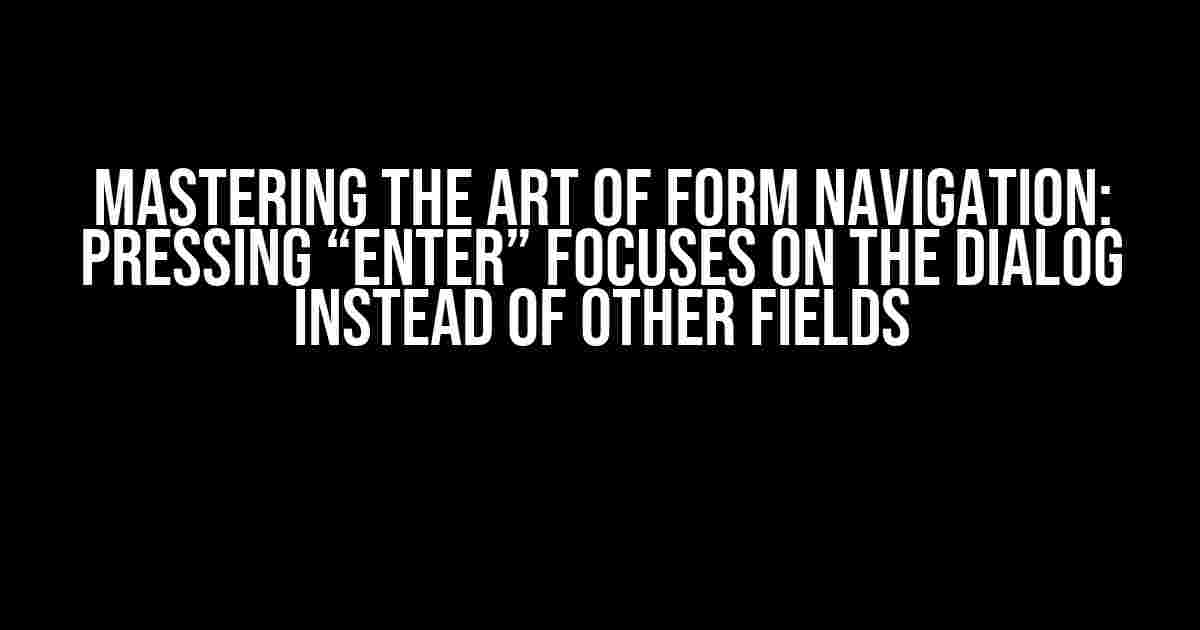Imagine filling out a lengthy online form, meticulously typing away, only to have your progress disrupted by a single misdirected key press. You’ve pressed the “Enter” key, expecting to move to the next field, but instead, the focus jumps to the dialog box, leaving you frustrated and wondering what just happened. Sound familiar? You’re not alone! In this article, we’ll delve into the world of form navigation, exploring the reasons behind this phenomenon and providing actionable solutions to tame the “Enter” key’s stubborn behavior.
Understanding the Culprit: The “Enter” Key’s Dual Personality
The “Enter” key, also known as the “Return” key, has a dual nature that often leads to confusion in form navigation. On one hand, it’s used to submit forms, which is its primary function. On the other hand, it can also be used to move the focus to the next field or element in a form, depending on the context and browser behavior.
Browser-Specific Behaviors: A Recipe for Confusion
One of the primary reasons for the “Enter” key’s inconsistent behavior lies in the varying browser implementations. Here’s a breakdown of how different browsers handle the “Enter” key press in forms:
- Google Chrome and Opera: In these browsers, pressing “Enter” will move the focus to the next field or element in the form, unless a submit button is explicitly defined.
- Mozilla Firefox: Firefox takes a more intuitive approach, moving the focus to the next field or element if no submit button is present. If a submit button is defined, pressing “Enter” will submit the form.
- Microsoft Edge and Internet Explorer: In these browsers, pressing “Enter” will always submit the form, regardless of the presence of a submit button.
This inconsistent behavior can lead to user frustration and confusion, especially when dealing with complex forms or multi-step processes.
Solving the Problem: Strategies for Taming the “Enter” Key
Fear not, dear reader! We’ve got a range of solutions to help you tame the “Enter” key’s unpredictable nature and create a seamless form navigation experience for your users.
1. Explicitly Define a Submit Button
One of the simplest ways to prevent the “Enter” key from jumping to the dialog box is to define a submit button explicitly. This tells the browser to treat the “Enter” key press as a form submission rather than a navigation action.
<form action="/submit"> <label for="name">Name:</label> <input type="text" id="name" name="name"> <label for="email">Email:</label> <input type="email" id="email" name="email"> <button type="submit">Submit</button> </form>
2. Use the `keyPress` Event to Capture and Redirect the “Enter” Key Press
Another approach is to capture the “Enter” key press event and redirect the focus to the next field or element in the form. This can be achieved using JavaScript and the `keyPress` event.
<script>
const form = document.getElementById('myForm');
form.addEventListener('keypress', (e) => {
if (e.keyCode === 13) { // 13 is the keyCode for the Enter key
e.preventDefault();
const nextField = form.elements[form.elements.indexOf(e.target) + 1];
if (nextField) {
nextField.focus();
}
}
});
</script>
3. Implement Form Field Navigation Using `tabindex` and `focus()`
A more elegant solution is to use the `tabindex` attribute to define the order in which form fields should be navigated. Then, use the `focus()` method to move the focus to the next field or element when the “Enter” key is pressed.
<form action="/submit">
<label for="name">Name:</label>
<input type="text" id="name" name="name" tabindex="1">
<label for="email">Email:</label>
<input type="email" id="email" name="email" tabindex="2">
<button type="submit" tabindex="3">Submit</button>
</form>
<script>
const form = document.getElementById('myForm');
form.addEventListener('keypress', (e) => {
if (e.keyCode === 13) { // 13 is the keyCode for the Enter key
e.preventDefault();
const currentIndex = form.elements.indexOf(e.target);
const nextIndex = currentIndex + 1;
const nextField = form.elements[nextIndex];
if (nextField) {
nextField.focus();
}
}
});
</script>
Best Practices for Form Navigation
While solving the “Enter” key conundrum is essential, it’s equally important to follow best practices for form navigation to ensure a seamless user experience:
- Use a logical `tabindex` order: Ensure that the `tabindex` attribute is assigned in a logical order, allowing users to navigate the form fields in a predictable manner.
- Provide a clear visual focus: Use CSS to highlight the currently focused field or element, helping users understand where they are in the form.
- Use accessible form labels: Associate form labels with their corresponding fields using the `for` attribute, enabling screen readers and assistive technologies to provide a better user experience.
- Test and iterate: Thoroughly test your form navigation on various devices and browsers, making adjustments as needed to ensure a consistent and intuitive experience.
Conclusion
In conclusion, the “Enter” key’s dual personality can lead to frustrating form navigation experiences, but by understanding the underlying browser behaviors and implementing the strategies outlined in this article, you can tame the “Enter” key’s unpredictable nature and create a seamless form navigation experience for your users. Remember to follow best practices for form navigation, and always test and iterate to ensure a consistent and intuitive experience across devices and browsers.
| Browser | Behavior |
|---|---|
| Google Chrome and Opera | Moves focus to next field or element if no submit button is present |
| Mozilla Firefox | Moves focus to next field or element if no submit button is present, submits form if submit button is defined |
| Microsoft Edge and Internet Explorer | Submits form regardless of presence of submit button |
By mastering the art of form navigation, you’ll be well on your way to creating a delightful and frustration-free experience for your users. Happy coding!
Frequently Asked Question
Get the scoop on pressing “enter” and its dialog-friendly habits!
Why does pressing “enter” focus on the dialog instead of other fields?
This is a default browser behavior, where the enter key is associated with form submission. When you press enter, the browser tries to submit the form by focusing on the first available dialog or button. To change this behavior, you can add a JavaScript event listener to capture the enter key press and prevent the default action.
How can I prevent the dialog from getting focus when pressing enter?
You can add an event listener to the input field and call the preventDefault() method when the enter key is pressed. This will stop the browser from submitting the form and focusing on the dialog. You can also add a tabIndex attribute to the input field to specify the order of focus.
Is this a browser-specific issue or a general web development problem?
This is a general web development problem, as it’s a default behavior implemented by most browsers. However, different browsers may handle the enter key press slightly differently, so it’s always a good idea to test your implementation in multiple browsers.
Can I change the default behavior of the enter key press in my web application?
Yes, you can change the default behavior of the enter key press by adding custom JavaScript code to handle the key press event. You can capture the enter key press and perform a different action, such as moving the focus to the next input field or submitting a specific form.
Are there any accessibility concerns with the default enter key behavior?
Yes, the default enter key behavior can cause accessibility issues for users who rely on keyboard navigation. By changing the default behavior, you can improve the overall accessibility of your web application and ensure a better user experience for all users.


